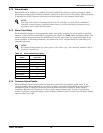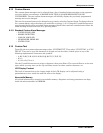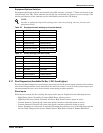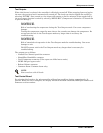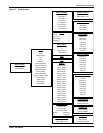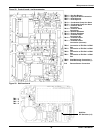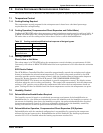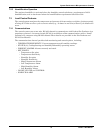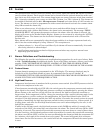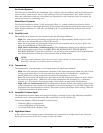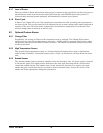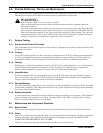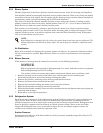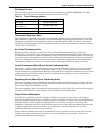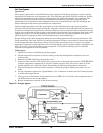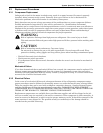
Alarms
Liebert
®
Mini-Mate2
™
52
8.0 ALARMS
The microprocessor control system will audibly and visually signal all ENABLED Alarms (including
two (2) custom alarms). These special alarms can be chosen from the optional alarm list and/or can
have their own fully custom text. The custom alarm inputs are contact closures wired from terminal
TB1-1 through a normally open contact to either TB1-2 (alarm 1) or TB1-3 (alarm 2). The alarms can
be enabled or disabled (refer to 6.0 - Microprocessor Control) and a time delay of 0-255 seconds can
be set. The alarms can also be programmed to either sound the alarm & activate the common alarm
relay OR to sound the alarm only.
When a new alarm occurs, it is displayed on the screen and the audible alarm is activated. (If
communicating with a Liebert Site Product, the alarm is also transmitted.) The message “PRESS
ALARM SILENCE” will prompt the operator to silence the alarm. After the alarm is silenced, the
display will return to the Normal Status Display. Alarms can be reviewed by selecting the “ACTIVE
ALARMS” feature. The alarms can also be silenced through communications with a Liebert Site
Product unit.
Many alarms will reset automatically when the alarm condition is no longer represented and only
after it has been acknowledged by being “Silenced.” The exceptions are:
1. software alarms, i.e., Loss of Power and Short Cycle alarms will reset automatically 30 seconds
after being silenced or acknowledged
2. specific alarms monitoring overload or high pressure switches may require a manual reset
depending upon the model
8.1 Alarms: Definitions and Troubleshooting
The following list provides a definition and troubleshooting suggestions for each type of alarm. Refer
to 11.0 - Troubleshooting for additional details. If you need further assistance, contact your Liebert
supplier. THE CUSTOMER MUST SPECIFY ALARM(S) AT THE TIME OF ORDER. OTHER
DEVICES AND WIRING MAY BE REQUIRED AT THE FACTORY FOR SOME OF THE ALARMS.
8.1.1 Custom Alarms
Custom alarm(s) messages are programmed at the LCD display. The message displayed may be
included in a list of provided alarms or it may be customized text (for up to 2 alarms). IF
CUSTOMIZED TEXT IS USED, MAINTENANCE PERSONNEL SHOULD BE INFORMED OF THE
ALARM FUNCTION AND THE REQUIRED ACTION.
8.1.2 High Head Pressure
Compressor head pressure is monitored with a pressure-sensor switch. (One SPDT pressure switch is
used) for the compressor in the unit.
If head pressure exceeds 400 psig (2785 kPa), the switch opens the compressor contactor and sends an
input signal to the control. The high head pressure condition is acknowledged by pressing the Alarm
Silence button on the wall box, which will clear the alarm if the high head pressure condition no
longer exists. If the compressor is Off for 1 hour, the control goes into a special cold start mode. In the
cold start mode on a call for cooling or dehumidification, the liquid line solenoid valve (LLSV) is
energized. If the high pressure switch does NOT trip within 10 seconds, the control returns to normal
operation of monitoring the high head pressure switch for three occurrences in a 12 hour period. It is
a rolling timer, and after the third high head alarm occurs and is acknowledged by the user, it will
lock Off the compressor.
If while in the cold start mode, the high head pressure switch DOES trip within 10 seconds of the
activation of the LLSV, the control does not annunciate the alarm. The control will turn Off the LLSV
and delay 10 seconds. The control will permit this occurrence two more times or a total of three times.
If on the fourth try, the high head pressure switch trips within 10 seconds, the control will annunciate
the alarm, turn Off the LLSV, wait for the user to acknowledge the alarm and hold the compressor Off
for 3 minutes, the length of the normal short cycle control. The control will permit this occurrence
three times. On the third occurrence, the control will lock the compressor Off until the control power
is reset.



